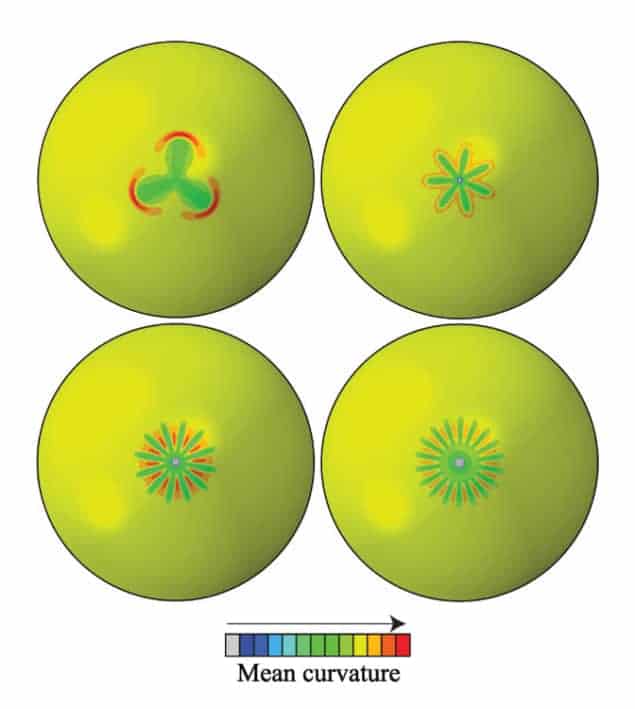
Poking a living cell and counting the number of wrinkles that form could provide scientists with a new way of measuring its internal pressure. That is the claim of physicists in the UK, the US and France, who have shown that the number of wrinkles that appear on a pressurized shell is determined by its internal pressure. The technique could be used to study how cells react to changes in their environment and improve tiny capsules used by the pharmaceutical industry.
If you push your finger into a beach ball, the indentation that you create will include a number of wrinkles that radiate outwards from your finger. However, if you do the same thing with a table-tennis ball, the result will be a much simpler three-lobed geometric pattern (see figure). An important difference between these examples is that the beach ball is pressurized and the table-tennis ball is not.
Dominic Vella of the University of Oxford and colleagues at Northeastern University in the US and the University of Lyon in France thought that this effect could be used to create a new technique for measuring the pressure inside such a shell – without the need to make a hole in it. Now, by using theory, computer simulations and experiments carried out on an exercise ball, they have worked out the relationship between the internal pressure of a shell, its elastic properties and the number of wrinkles that appear when it is prodded.
Pressure threshold
In its work, the team used a commercial software package for finite element analysis (called ABAQUS) to simulate a large shell of aluminium 1 m in radius and 2 mm thick. The simulations were performed at pressure differences between the inside and outside of the shell that ranged from zero to 15 MPa. The simulations suggest that, above a certain pressure, the number of wrinkles can be calculated from the square root of the pressure. Below this pressure, the three-lobed pattern seen in a table-tennis ball is predicted.
The computer simulations agree with both the team’s mathematical derivation of the relationship between wrinkle-number and pressure, and a small number of experiments done on a Pezzi exercise ball.
Vella told physicsworld.com that the team’s findings could be used to study how the pressure inside a living cell changes in response to changes in the local environment, such as the concentration of salt. If the thickness and elasticity of the cell wall or membrane is known, then the internal pressure can be determined by carefully poking the cell with a known force and counting the wrinkles. He also believes that the technique could be used to determine the internal pressures of tiny spherical capsules (about 100 µm in diameter) that are used to deliver drugs.
‘Beautiful’ finding
Pedro Reis of the Massachusetts Institute of Technology in the US describes the work as “an extremely elegant and thorough investigation of wrinkling in thin shells under pressure”, adding that Vella and colleagues’ technique is “beautiful”.
“It is an open invitation for experimentalists, biologists, physicists and material scientists alike, to get to the lab and use this new testing framework as a tool to measure the mechanical properties of synthetic and biological pressurized shells,” he adds.
The research is described in Phys. Rev. Lett. 107 174301.



